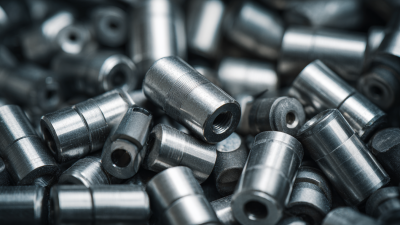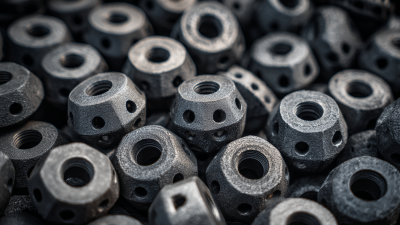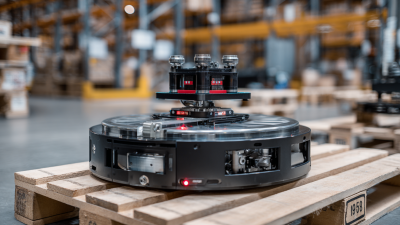How to Choose the Right Zirconia Ceramic Parts for Your Application
Table of Contents
- Understanding the Properties of Zirconia Ceramics for Industrial Applications
- Evaluating Your Application's Specific Requirements for Zirconia Parts
- Comparing Different Types of Zirconia Ceramics Available on the Market
- Assessing the Manufacturing Processes for Zirconia Ceramic Components
- Recognizing Key Performance Metrics When Selecting Zirconia Parts
- FAQS
- Conclusion
- Related Posts
 Zirconia Ceramic Parts have gained significant attention in various industries due to their exceptional properties, including high wear resistance, low thermal conductivity, and excellent mechanical strength. According to a market research report by MarketsandMarkets, the global ceramic materials market is projected to reach USD 228.0 billion by 2025, with zirconia ceramics being a key contributor to this growth, particularly in sectors such as aerospace, automotive, and healthcare.
Zirconia Ceramic Parts have gained significant attention in various industries due to their exceptional properties, including high wear resistance, low thermal conductivity, and excellent mechanical strength. According to a market research report by MarketsandMarkets, the global ceramic materials market is projected to reach USD 228.0 billion by 2025, with zirconia ceramics being a key contributor to this growth, particularly in sectors such as aerospace, automotive, and healthcare.
At ST.CERA CO., LTD., we specialize in precision ceramic manufacturing, backed by a team of top-ranking experts and engineers. Our focus on research and development, alongside our commitment to high-quality production, positions us as a leader in providing tailored zirconia ceramic parts that meet the stringent demands of diverse applications.
Understanding the unique characteristics and requirements of zirconia ceramics is essential for optimizing performance and achieving desirable outcomes in your projects.
Understanding the Properties of Zirconia Ceramics for Industrial Applications
Zirconia ceramics are prized in various industrial applications due to their exceptional properties, which include high strength, toughness, and wear resistance. According to a report by Research and Markets, the global zirconia ceramic market is expected to reach $3.58 billion by 2024, reflecting a growing demand across sectors such as automotive, electronics, and medical devices. These ceramics exhibit low thermal conductivity and high resistance to corrosion, making them suitable for demanding environments where conventional materials may fail.
The mechanical strength of zirconia ceramics can be particularly advantageous in applications like dental restorations and cutting tools. Data from the Journal of Materials Science indicates that zirconia can have a flexural strength exceeding 1,200 MPa, which is significantly higher than that of traditional ceramics. Additionally, zirconia's ability to withstand high temperatures up to 1,500°C allows for its use in thermal barriers and insulating applications. Understanding these properties is crucial when selecting zirconia ceramic parts, as they can leverage unique qualities to enhance performance and longevity in various industrial applications.
How to Choose the Right Zirconia Ceramic Parts for Your Application - Understanding the Properties of Zirconia Ceramics for Industrial Applications
| Property | Description | Typical Values | Applications |
|---|---|---|---|
| Density | Mass per unit volume | 6 g/cm3 | Implants, dental applications |
| Flexural Strength | Resistance to bending | 800 MPa | Cutting tools, surgical instruments |
| Thermal Conductivity | Ability to conduct heat | 2 W/m·K | Heat exchangers, thermal barrier coatings |
| Hardness | Resistance to abrasion | 1200 HV | Manufacturing tools, wear-resistant parts |
| Fracture Toughness | Resistance to crack propagation | 5 MPa·m1/2 | Aerospace components, dental ceramics |
Evaluating Your Application's Specific Requirements for Zirconia Parts
When selecting zirconia ceramic parts for your specific application, it’s crucial to evaluate the unique requirements of your project. Begin by considering the operating environment, including factors such as temperature, humidity, and exposure to chemicals. Zirconia ceramics are known for their exceptional durability and resistance to wear, making them suitable for high-stress applications. Identifying the operational challenges your parts will face helps in choosing the right formulation and design.
Next, assess the mechanical properties that are essential for your application. Zirconia can have varying degrees of toughness, hardness, and flexibility depending on its composition and processing. If your application requires components to withstand significant impact or compressive forces, prioritizing tougher zirconia variants will be essential. Additionally, consider thermal properties if the parts will be subjected to extreme temperatures, as some zirconia parts maintain stability better than others under thermal stress. By closely evaluating these specific requirements, you can ensure that the zirconia parts you choose will perform optimally in your intended application.
Comparative Analysis of Zirconia Ceramic Parts Characteristics
This bar chart represents the key characteristics of zirconia ceramic parts, showcasing their tensile strength, hardness, thermal conductivity, and density, which are crucial for selecting the right components for specific applications.
Comparing Different Types of Zirconia Ceramics Available on the Market
When selecting zirconia ceramic parts for specific applications, it's crucial to understand the various types available on the market. The most common types of zirconia ceramics include partially stabilized zirconia (PSZ), fully stabilized zirconia (FSZ), and zirconia toughened alumina (ZTA). PSZ is often preferred for moderately demanding applications due to its excellent fracture toughness, while FSZ is utilized in environments requiring higher temperature stability and corrosion resistance.
 Another key variant is ZTA, which combines zirconia with alumina to enhance hardness and wear resistance. This makes ZTA particularly suitable for applications in cutting tools and dental prosthetics, where durability is critical. It's essential to consider the specific mechanical properties and thermal characteristics of each type, as they directly impact performance in different environments. Understanding these distinctions will guide you in choosing the optimal zirconia ceramic parts that align with your technical requirements and operational needs.
Another key variant is ZTA, which combines zirconia with alumina to enhance hardness and wear resistance. This makes ZTA particularly suitable for applications in cutting tools and dental prosthetics, where durability is critical. It's essential to consider the specific mechanical properties and thermal characteristics of each type, as they directly impact performance in different environments. Understanding these distinctions will guide you in choosing the optimal zirconia ceramic parts that align with your technical requirements and operational needs.
Assessing the Manufacturing Processes for Zirconia Ceramic Components
When assessing the manufacturing processes for zirconia ceramic components, several techniques can be employed, each impacting the final product's properties such as strength, wear resistance, and thermal stability. The most common methods include pressing, injection molding, and additive manufacturing. According to a 2022 report by TechSci Research, the global zirconia ceramics market is expected to reach $10.4 billion by 2027, highlighting the growing importance of efficient and precise manufacturing processes in meeting increasing demand.

Injection molding, for instance, allows for complex geometries and high-volume production, making it suitable for applications in the automotive and medical sectors. The ability to create intricate designs while maintaining dimensional accuracy is crucial; studies have shown that components produced through injection molding exhibit up to 30% better mechanical properties than those produced through conventional pressing methods. Additionally, additive manufacturing is making strides in optimizing zirconia ceramics for bespoke applications, offering tailored solutions with reduced lead times, as reported by the Journal of Materials Science in 2023. This innovation is particularly valuable in industries requiring high-performance components with specific characteristics, reinforcing the necessity for a careful analysis of the chosen manufacturing process.
Recognizing Key Performance Metrics When Selecting Zirconia Parts
When selecting zirconia ceramic parts for specific applications, it is crucial to recognize the key performance metrics that will influence the efficacy of the components. Factors such as mechanical strength, wear resistance, and thermal stability are paramount. The recent advancements in additive manufacturing, particularly through processes like NanoParticle Jetting, have significantly enhanced the ability to produce dense zirconia components with highly detailed surfaces. This method allows for greater design freedom while ensuring that the parts meet stringent performance requirements.
Another aspect to consider is the formulation of binders used in filament feedstocks for material extrusion additive manufacturing. The interactive effects of various binder components—such as the backbone, elastomer, and surfactant—on filament properties can greatly impact the final performance of the ceramic parts. Innovations in machining processes, like the magnetic abrasive finishing of zirconium alloy tubes using composites, further demonstrate the importance of selecting the right zirconia parts tailored for specific machining needs. At ST.CERA CO., LTD., we leverage our expertise in precision ceramic manufacturing to offer solutions that are optimized for high performance and durability in diverse applications.
FAQS
: Zirconia ceramics are known for their high strength, toughness, wear resistance, low thermal conductivity, and high corrosion resistance, making them suitable for demanding environments.
The common types of zirconia ceramics include partially stabilized zirconia (PSZ), fully stabilized zirconia (FSZ), and zirconia toughened alumina (ZTA), each suited for different applications based on their mechanical properties and thermal characteristics.
The mechanical strength of zirconia ceramics, with flexural strength often exceeding 1,200 MPa, is particularly beneficial in applications like dental restorations and cutting tools, enhancing durability and performance.
Common manufacturing processes for zirconia ceramic components include pressing, injection molding, and additive manufacturing, each influencing the final product's strength, wear resistance, and thermal stability.
Injection molding allows for complex geometries and high-volume production, producing components with up to 30% better mechanical properties compared to those made through conventional pressing methods.
It's crucial because each type has unique mechanical properties and thermal characteristics that directly impact performance, guiding the selection of optimal parts for specific technical requirements.
The global zirconia ceramic market is projected to grow significantly, reaching $3.58 billion by 2024 and $10.4 billion by 2027, indicating increasing demand across various sectors.
Additive manufacturing optimizes zirconia ceramics for bespoke applications, offering tailored solutions with reduced lead times, which is particularly valuable in high-performance industries.
Conclusion
When selecting the right Zirconia Ceramic Parts for your specific applications, it is crucial to understand the unique properties of zirconia ceramics, such as their strength, toughness, and resistance to wear and corrosion. Evaluating the specific requirements of your application will help determine the most suitable type of zirconia ceramic, as there are various options available on the market.
Moreover, it's important to assess the manufacturing processes employed for these zirconia components, as this can significantly impact their performance. Key performance metrics, such as durability and thermal stability, should also be considered. At St.Cera Co., Ltd., we specialize in precision ceramic manufacturing, offering expert insights into research, development, and marketing of high-quality Zirconia Ceramic Parts to meet industrial needs effectively.
Related Posts
-

How to Choose the Right Zirconia Dowel Pins for Your Manufacturing Needs
-

The Ultimate Guide to Zirconia Ceramic Rods: Unveiling Key Properties and Market Trends
-

7 Essential Tips for Sourcing the Best Silicon Carbide Bushing Globally
-

Ultimate Guide to Sourcing the Best Sic Wafer Arm for Your Manufacturing Needs
-

How to Choose the Right Bernoulli Ceramic End Effector for Your Automation Needs
-

10 Essential Tips for Choosing the Best Ceramic Rollers
Blog Tags:

